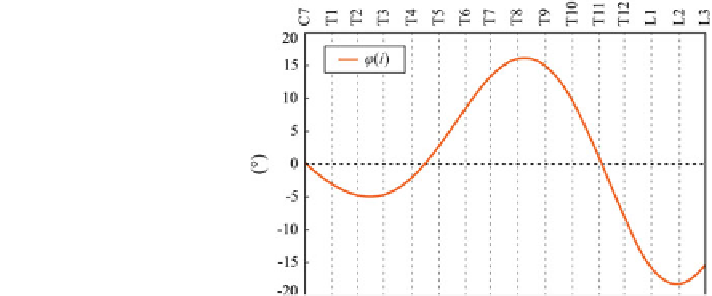Information Technology Reference
In-Depth Information
2.2.2 Axial Vertebral Rotation
Axial vertebral rotation is the rotation
U
of vertebrae around their longitudinal axes
when projected onto the transverse plane of the corresponding coordinate system. If
i is an independent parameter that denotes an arbitrary location on the spine, then
uð
i
Þ
is the parametrization of the axial vertebral rotation
U
:
U:
uð
Þ;
2
½
i
sp
;
i
ep
;
ð
Þ
i
i
12
where i
i
ep
represent the locations on the spine at its start and end
point of observation, respectively. For K observed consecutive vertebrae, let angles
fdð
¼
i
sp
and i
¼
represent the corresponding axial vertebral rotation angles.
The axial vertebral rotation
uð
k
Þ;
k
¼
1
;
2
; ...;
K
g
i
Þ
can be then obtained by continuous interpolation of
dð
(Fig.
6
).
Axial vertebral rotation cannot be uniformly measured, as the vertebral anatomy
observed in the transverse plane is not completely symmetrical due to normal
developmental as well as pathological conditions affecting the spine. As a result,
several methods were developed to determine axial vertebral rotation from 3D
images of the spine [
88
] that measured the angle between the reference sagittal
plane and a line connecting speci
k
Þ
between
uð
i
sp
Þ
¼
dð
1
Þ
and
uð
i
ep
Þ
¼
dð
K
Þ
c anatomical reference points in the transverse
plane. For example, axial vertebral rotation was measured as the angle between the
reference sagittal plane and the line connecting the posterior junction of the two
laminae of the vertebral arch with the center of vertebral body [
1
], as the angle
between the reference sagittal plane and the line bisecting the angle between the
two lines connecting the junction of each lamina and the pedicle with the posterior
junction of the two laminae [
26
], as the angle between the reference sagittal plane
and the line connecting the tip of the spinous process with the center of vertebral
body [
39
], or as the angle between the reference sagittal plane and the line con-
necting the most posterior points of the two pedicles [
20
].
Let points rðiÞ
represent locations of the selected anatom-
ical reference points in the corresponding transverse planes of measurement, and let
ð
i
Þ
¼
ð
r
x
ð
i
Þ;
r
y
ð
i
Þ;
r
z
ð
i
ÞÞ
Fig. 6 The axial vertebral
rotation
uð
i
Þ
against the
independent parameter
i
2
½0
;
1
. Labels C7, T1,
…
,
L3 indicate vertebral
segments (Note The spine
corresponds to Fig.
1
)

